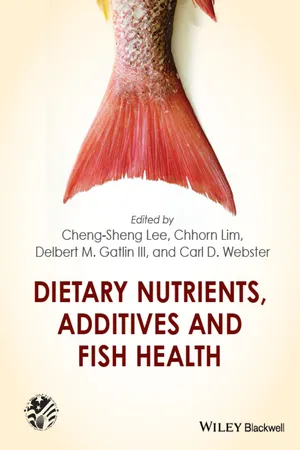
- English
- ePUB (mobile friendly)
- Available on iOS & Android
Dietary Nutrients, Additives and Fish Health
About this book
Fish nutrition can be the deciding factor between a robust and healthy farmed fish population and low aquaculture production. In an age where chemicals and antibiotics are under greater scrutiny than ever, a strong understanding of the role of nutrients and feed additives is essential in the aquaculture industry.
Dietary Nutrients, Additives and Fish Health is a comprehensive review of dietary nutrients, antinutritional factors and toxins, and non-nutrient dietary additives, and their effects on fish performance and immune system function, as well as overall health.
The book opens with an overview of fish immune systems and health. Subsequent chapters delve into proteins and amino acids, lipids and fatty acids, carbohydrates, beta glucans, vitamins, minerals, antinutrients, mycotoxins, nucleotides, prebiotics, probiotics, organic acids and their salts, and plant extracts and their impacts on fish health, growth, and development. The text then concludes with a chapter on feeding practices.
Authored by leaders in aquaculture, Dietary Nutrients, Additives and Fish Health will be an invaluable resource to graduate students, researchers and professionals alike.
Frequently asked questions
- Essential is ideal for learners and professionals who enjoy exploring a wide range of subjects. Access the Essential Library with 800,000+ trusted titles and best-sellers across business, personal growth, and the humanities. Includes unlimited reading time and Standard Read Aloud voice.
- Complete: Perfect for advanced learners and researchers needing full, unrestricted access. Unlock 1.4M+ books across hundreds of subjects, including academic and specialized titles. The Complete Plan also includes advanced features like Premium Read Aloud and Research Assistant.
Please note we cannot support devices running on iOS 13 and Android 7 or earlier. Learn more about using the app.
Information
Chapter 1
Overview of Fish Immune System and Infectious Diseases
Introduction
Immune Organs and Tissues
Thymus
Kidney
Spleen
Gut
Table of contents
- Cover
- Title Page
- Copyright
- Contents
- List of Contributors
- Preface
- Acknowledgements
- 1. Overview of Fish Immune System and Infectious Diseases
- 2. Protein, Amino Acids, and Ingredients
- 3. Lipids and Fatty Acids
- 4. Carbohydrates
- 5. β-Glucans
- 6. Vitamins (Excluding C and E)
- 7. The Effect of Vitamin C on Fish Health
- 8. Vitamin E
- 9. Minerals
- 10. Antinutrients
- 11. Mycotoxin Contamination of Fish Feeds
- 12. Nucleotides
- 13. Prebiotics
- 14. Gastrointestinal Microorganisms of Fish and Probiotics
- 15. Organic Acids and Their Salts
- 16. Plant Extracts
- 17. Feeding Practices and Fish Health
- Index
- End User License Agreement